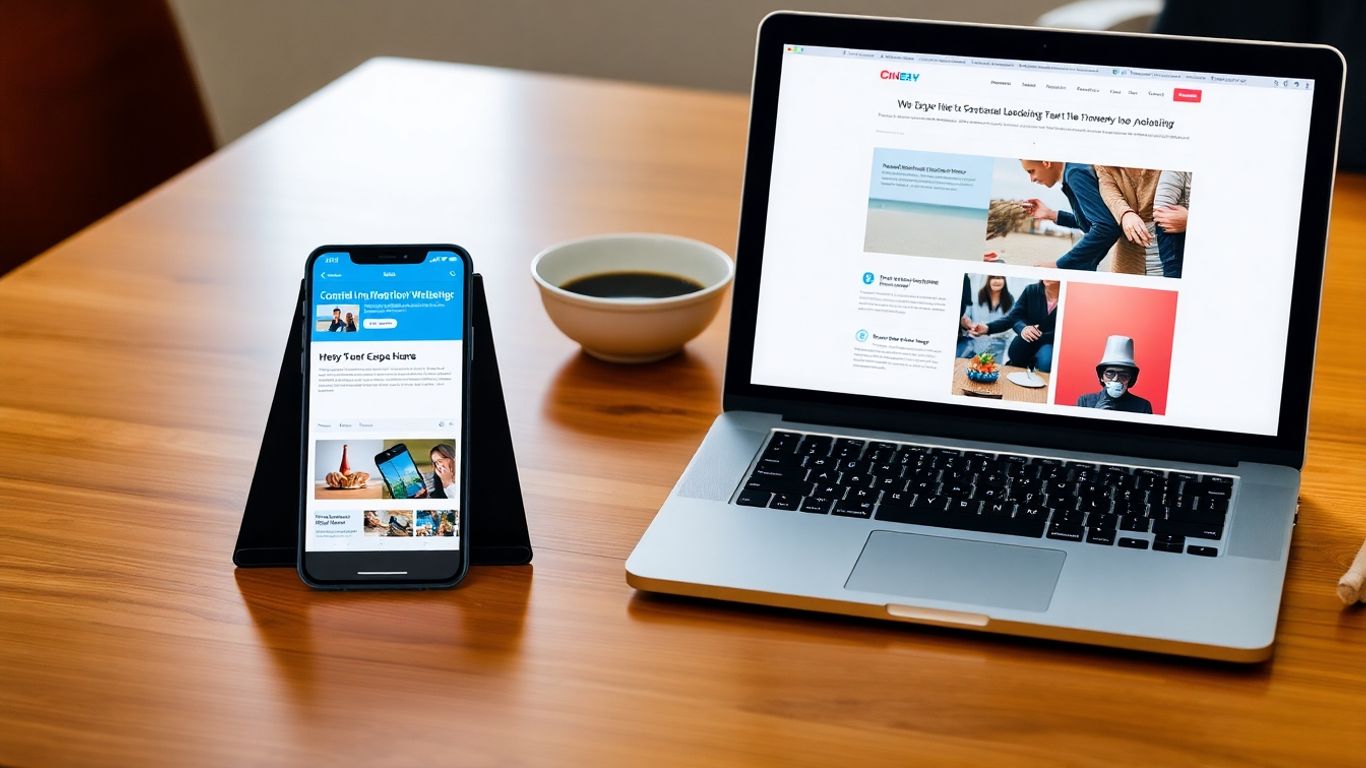
It’s near 2026, and just about everyone you know is glued to their phone. Whenever you need to look something up, order food, or check the weather, you’re probably reaching for your mobile device. This shift isn’t just a trend—it’s changed how websites are built and how they show up in search results. If your site doesn’t work well on a phone, you’re losing out. Responsive Website SEO is all about making sure your site looks good, loads fast, and is easy to use on any device. In this article, we’ll break down why mobile-first design is more important than ever and what you can do to stay ahead.
Mobile-first design isn’t just a trend anymore—it’s become the default mode of thinking about building websites. In 2026, with so many people glued to their phones and tablets, Google pretty much assumes everyone visits your site from something handheld. That means your website needs to look and work great on the smallest screens first, or you’ll drop in the rankings.
Search engines care a lot about how well a site plays on mobile. If your site doesn’t load fast, or buttons are tough to use on a phone, your rankings will take a hit. Google’s ranking system starts by looking at the mobile version of your website, so any missing info or weird formatting will work against you. Here’s what really affects search rankings nowadays:
| Factor | Effect on Ranking |
|---|---|
| Mobile loading speed | High |
| Mobile usability (buttons/menus) | High |
| Content parity (mobile vs desktop) | High |
| Desktop-only features/content | Negative |
| Pop-ups/interstitials on mobile | Negative |
If you want to show up on search results, start your design for mobile, make sure everything’s easy to use, then add extras for bigger screens.
Almost everyone expects websites to load instantly and run smoothly, no matter what device they’re using. If a site makes you wait or forces you to scroll sideways, that’s a quick way to lose visitors and any potential sales.
Phones now come in all shapes—tiny, huge, foldable, even circular for wearables. Designing for this mess of screens is tough, so testing matters more than ever. Common headaches include:
You’ve got to plan for:
Focusing on the mobile-first approach means less frustration for visitors and better odds of showing up high in search results.
Over the last few years, Google really shifted how websites are ranked. If you’re not familiar, mobile-first indexing means that Google mostly looks at your mobile site as the main version when figuring out your search rankings. This practice is here to stay through 2026 and has a ripple effect across everything from page layout to structured data.
Mobile-first indexing is the default, not just a trend. If your site has a barebones or incomplete mobile version, Google sees your entire website as lacking key content. This can send your rankings tumbling. Here are a few quick things to keep top of mind:
It’s smart to treat your mobile site as your real homepage, not just a side gig. Think of it as the front door for most of your visitors.
Keeping your content and structured data synced across both desktop and mobile is key. Inconsistent layouts, hidden text, or mismatched meta descriptions can cause search bots to misunderstand or skip your pages. For best results:
| Mobile Content | Desktop Content | SEO Effect |
|---|---|---|
| Identical | Identical | Good rankings |
| Incomplete | Full | Poor rankings |
| Different | Different | Unpredictable |
For extra technical insights on this, check out how optimizing Core Web Vitals can impact SEO and mobile indexing.
So many sites trip up here. Avoid these pitfalls:
The easiest way to spot issues? Run mobile audits regularly. Google Search Console is your friend here.
Mobile-first indexing is really about putting your best digital foot forward for every device—no shortcuts, no half-measures. Keep things in sync and you’ll keep your site visible in search results through today and well into next year.
Site performance on mobile plays a huge part in how your page ranks—and how people interact with it. If your website feels slow or awkward on a phone, users will notice, and so will search engines. Here’s how to dial in your site’s performance so you don’t miss out on mobile traffic in 2026.
Mobile users aren’t patient—if your site isn’t speedy, they’ll be gone in seconds. Most people will leave if your page takes longer than three seconds to load. Here’s what you can do:
Short attention spans mean site speed is just as important for users as it is for SEO. Speed improvements often bring higher conversions, too.
| Load Time (Seconds) | Expected Bounce Rate |
|---|---|
| 1-2 | 10% |
| 3-4 | 24% |
| 5+ | 38% |
Users on slow connections judge your site’s quality by its speed before content even loads.
Responsive design is more than just squeezing your site onto a smaller screen. It’s about making it actually work for mobile users. Try these:
A responsive site leads to less user frustration, helping you hold onto both visitors and your SEO.
Google’s Core Web Vitals remain a major part of ranking in 2026. These metrics focus on how real people experience your website:
Steps for better scores:
| Core Web Vital | Good Threshold |
|---|---|
| LCP | <2.5 seconds |
| INP | <200 milliseconds |
| CLS | <0.1 |
Improving these scores boosts both SEO and user satisfaction on mobile devices.
By focusing on these areas, you make sure your site doesn’t just show up on a phone—it works fast and gets noticed.

When people grab their phones to look something up, they’re in a hurry. You have to meet them where they are. I’ve noticed that many businesses boost engagement by just making it really easy to skim their pages and tap what matters most. Let’s map out exactly how you can do this in 2026.
Smartphones mean smaller screens and more distractions. If you don’t organize your content the right way, you’ll lose people fast. Here’s how you keep them reading:
| Tactic | Effect on Readability |
|---|---|
| Short paragraphs | Faster skimming |
| Bullet points/lists | Better content digestion |
| Clear, direct headings | Easier navigation |
| Bigger font (16px+) | No pinching, no zooming |
People often trust a mobile site more if it’s tidy and scannable, even if the info is the same as a cluttered desktop version.
Making buttons easy to see and tap is half the battle. Here’s what works for CTAs on mobile:
And since mobile-first web design means people can’t hover with their cursor, every important action should be visible or obvious without fiddling around.
If your site isn’t usable for everyone, you’re missing out. True accessibility isn’t flashy, but it’s easy to overlook small stuff:
If you want people to actually engage, combine clarity, simple language, and clear structure across mobile devices. That’s the real path to strong local authenticity (outperforming competitors in local markets).
Making your site readable on mobile is about respecting peoples’ time and their devices. Focus on skimmable layouts, easy taps, and accessibility, and watch your engagement numbers grow, even as new tech arrives.

Mobile users depend on fast answers. They want a site that responds when they’re out running errands or driving to dinner. Local and voice search are two ways this shows up in daily life, and getting your responsive site ready for both matters more than ever in 2026.
A lot of searches that happen on phones have local intent—people want to find something nearby, right now. If your site isn’t ready for these searches, you’re just missing easy traffic. Here’s how to step it up:
| Local SEO Factor | How It Impacts Mobile Users |
|---|---|
| Google Business Profile | Shows in Maps and local pack results |
| Location Keywords | Ranks for “near me” and city-specific terms |
| NAP Consistency | Increases trust and ranking |
| Schema Markup | Enables rich local results in search |
Even small businesses can compete in local search—consistency and accuracy go a long way.
The way people search with their voice is not the same as they type. Voice queries are longer, more conversational, and usually loaded with intent. People use voice search while walking, driving, or multitasking—so your answers have to be direct.
Some real steps that help:
Don’t forget to update your content to match what people ask out loud—not what you think they type when they search.
Schema markup is a behind-the-scenes code but, wow, does it make a difference for mobile SEO. It helps search engines understand what your pages mean—not just what they say. This is especially useful for local businesses and voice queries.
The results of good schema? Search engines can pull up your phone number, address, hours, or answers right into the results page. That gets you picked up by voice assistants and shown to people looking for you on the go.
The little details in your site’s code—like schema—make a big difference in how easy you are to find from a phone. Don’t skip this step.
The world of mobile-first and responsive SEO is always evolving, and what worked in 2024 might need a major update today. Tech keeps pushing forward, and, honestly, users expect more out of their mobile experiences than ever. Let’s look at a few of the most interesting changes shaking up mobile-first SEO strategies in 2026.
Foldable phones, weirdly-shaped screens, and even wearable tech—they’re all here, and they change how we have to think about web design. A website can’t be a one-size-fits-all deal anymore.
| Device Type | Design Challenge | Solution Example |
|---|---|---|
| Foldables | Varying screen sizes | Dynamic column layout |
| Wearables | Tiny displays | Focused, minimal interfaces |
| Tablets/Hybrids | Dual orientation | Flexible, responsive breakpoints |
Some days it feels like you just figured out one device…and then a new screen shape pops up. Rolling with these changes is just part of the job now.
AI is quietly everywhere. It helps search engines understand what users want on mobile, and it can even drive real-time website adjustments.
Here’s how AI is showing up in mobile-first SEO:
Personalization used to be a bonus, but in 2026 it’s kind of the norm. Don’t be the site that feels stuck in last decade’s tech.
Progressive Web Apps (PWAs) started off as a trendy experiment, but now they’re mainstream for lots of brands. PWAs give users the app-like speed and offline function some expect, but right in their browser.
Here’s why PWAs matter for mobile SEO in 2026:
| PWA Feature | SEO Impact |
|---|---|
| Offline Access | Better user retention |
| Faster Loading | Lower bounce rates |
| Home Screen Shortcut | Higher engagement |
Mobile-first isn’t just about shrinking a desktop site anymore. It’s about staying ready for whatever device (and tech) users bring tomorrow.
If you’re trying to figure out if your responsive website actually works for SEO in 2026, you need to pay attention to more than just rankings. The truth is, it all comes down to how people interact with your site on their phones or tablets—and how well those visits turn into real results. Let’s break down what you should check and how to track real progress.
A bounce rate tells you if visitors are leaving your site right after landing. On mobile, people are quick to leave if your site loads slowly or looks messy on their screen. You want to see lower bounce rates—this usually means your site is easy to use and what visitors expected.
Seeing fewer people bounce from your mobile site is a strong sign your responsive design is doing its job.
At the end of the day, getting visitors to take action—buy, sign up, call—is the real win. Conversion rate on mobile can look different from desktop, so measuring it separately matters.
Here’s a simple table to keep things tidy:
| Metric | Expected in 2026 | Why It Matters |
|---|---|---|
| Bounce Rate | Under 40% | Shows user satisfaction |
| Conversion Rate | 2-5% (average) | Shows business results |
| Session Length | 1-2 minutes+ | Suggests engagement |
A good mobile conversion rate means your site loads fast, runs smoothly, and your calls-to-action work well for fingers—not just mouse clicks.
You can’t improve what you don’t measure. The good news: tools make it simple—if you know what to watch.
It’s worth checking these regularly, not just when something feels off. Set up alerts for things like sudden jumps in bounce rates or drops in conversion.
When you track the right things, your website keeps up with how visitors and devices change—without any guessing.
By focusing on bounce rate, conversion, and engagement, plus the right analytics, you won’t just have a responsive website—you’ll have one that wins on mobile, too.
So, wrapping this all up—if you’re still treating your website’s mobile experience as an afterthought, 2026 is the year to change that. People are glued to their phones, and search engines know it. A responsive, mobile-first site isn’t just a nice-to-have anymore; it’s the baseline for showing up in search and keeping visitors around. Sites that load quickly, look good on any screen, and are easy to use will always win out. If you want to keep up (or get ahead), focus on making your site work great on mobile first, then worry about the rest. It might feel like a lot to juggle, but the payoff—more visitors, better rankings, and happier users—is worth it. In the end, mobile-first isn’t just a trend. It’s how the web works now.
Mobile-first design means building your website for phones and tablets before thinking about desktops. In 2026, search engines like Google mostly look at your mobile site to decide how you rank. If your site works well on phones, you’ll likely show up higher in search results.
If your website loads slowly on a phone, people will leave before it even finishes. In fact, over half of users will exit if a page takes longer than three seconds to load. Fast sites keep visitors happy and help you rank better in search engines.
Keep things simple! Use big buttons, short paragraphs, and make sure everything fits on the screen without zooming. Also, test your site on real phones to spot any problems.
Mobile-first indexing means Google checks your mobile site first when deciding where you show up in search results. If your mobile site is missing important content or isn’t easy to use, your rankings could drop.
Use short sentences and paragraphs, add headings, and leave lots of space between things. Make sure the text is big enough to read without zooming, and avoid pop-ups that block the screen.
Yes! More people are using voice assistants to search on their phones. Try to answer common questions clearly and use simple language, so your site is more likely to show up in voice search results.